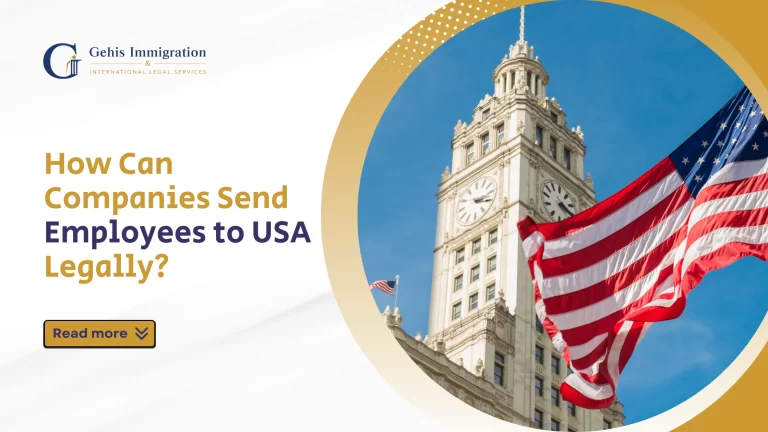In today’s economy, companies looking to expand internationally frequently Send Employees to the USA. These transfers entail shifting personnel from one nation to another, either temporarily or permanently, to suit the organization’s demands. International transfers occur for reasons like cross-border projects, skill development, or filling key positions.
Send Employees to the USA can take different forms, including short-term assignments, long-term assignments, and permanent transfers. Short-term assignments typically last a few months to a year, while long-term assignments may last several years. Permanent transfers involve permanently relocating an employee to a new country.
Due to the multitude of rules and regulations across jurisdictions, legal compliance is crucial for international employee transfers. Consequently, companies involved in cross-border employment must handle numerous legal obligations, encompassing immigration regulations, tax restrictions, and host country-specific employment laws.
Ensuring legal compliance is important for both employers and employees. Failure to follow the host country’s rules can have profound implications, such as penalties, legal conflicts, and significant reputational damage. Compliance helps create a pleasant employee experience by facilitating a smooth transition for the moved employee and maintaining a strong connection with local authorities.
To successfully manage international employee transfers, businesses must remain current on changes in law in both the home and host countries. This includes comprehending visa and work permit requirements, tax duties, and employment contract rules. Seeking legal assistance and establishing good communication channels with appropriate authorities are vital to ensuring compliance throughout the transfer process.
To achieve global business success, it’s crucial to understand foreign employee transfers and commit to following regulations. Companies can support their employees in transitioning smoothly and minimize risks associated with cross-border work by navigating intricate regulatory systems.
What is the U.S. Immigration System?
The United States has an elaborate immigration system to govern foreign people’s admission and residence. Understanding this procedure is crucial for organizations involved in transferring foreign personnel to the US. The US immigration system is overseen by a number of federal departments, including US Citizenship and Immigration Services (USCIS), the Department of State, and US Customs and Border Protection.
Types of Visas to Send Employees to the USA
– H-1B Visa for Specialty Occupations
The H-1B visa is for foreign nationals in specialized jobs, often in IT, engineering, and science. Employers must prove that the job needs advanced skills and that the worker has the necessary qualifications.
– L-1 Visa for Intracompany Transfers
The L-1 visa facilitates the intracompany transfer of employees within multinational companies. It has two subcategories: L-1A for managers and executives and L-1B for employees with specialized knowledge. To qualify, the employee must have worked for the company’s foreign office for at least one continuous year within the preceding three years.
– E-2 Visa for Treaty Investors
The E-2 visa is for individuals from countries with a treaty of commerce and navigation with the U.S. It allows investors to work in businesses where they have made a substantial investment. Unlike other employment-based visas, the E-2 visa does not have strict educational or occupational requirements.
– O Visa for Individuals with Extraordinary Ability
The O visa is for individuals with extraordinary ability or achievement in science, education, business, athletics, or the arts. It is divided into categories, including O-1A for those with exceptional ability in the sciences, education, business, or athletics, and O-1B for individuals with extraordinary arts or achievements in the motion picture or television industry.
Eligibility Criteria for Each Visa Type
Every visa type has particular requirements that both employers and employees need to fulfill. These criteria may involve education, work experience, job duties, and sometimes, a relationship between employer and employee. Employers must submit detailed documentation to support their petition for a specific visa category, and employees must fulfill the requirements outlined by the USCIS for each visa type.
The Application Process to Send Employees to the USA
Selecting an appropriate visa category is an essential step in the application process. The choice should be consistent with the nature of the international employee transfer and the employee’s credentials. Consider the objective of the transfer, the length of stay, and the specific requirements for each visa type, such as the H-1B, L-1, E-2, or O visa. Consulting with immigration specialists or legal professionals can assist in determining the best visa category for the specific circumstances.
Once the visa category is determined, the employer must initiate the petition process. This typically involves the submission of a petition to the appropriate U.S. government agency, such as the USCIS. The petition should include detailed information about the employer, the position, and the employee, along with supporting documentation. Employers filing H-1B or L-1 petitions must pay attention to specific filing fees and deadlines.
For H-1B visa applications, employers are required to file a Labor Condition Application (LCA) with the U.S. Department of Labor (DOL) before submitting the H-1B petition to the USCIS. The LCA ensures that the employment of the H-1B worker will not adversely affect the working conditions of similarly employed U.S. workers. Employers must comply with prevailing wage requirements and other conditions specified in the LCA.
Petition for a Nonimmigrant Worker
The Petition for a Nonimmigrant Worker is an important document in the application process for several nonimmigrant visas, including the H-1B, L-1, and O visas. This form is the official petition sent to the USCIS, containing information about the employer, employee, employment position, and other important elements. It is important to fill out the form correctly and include any necessary paperwork to support the petition.
Once the USCIS approves the petition, the employee must apply for a visa at a U.S. consulate or embassy in their home country. Most nonimmigrant visas like H-1B, L-1, E-2, and O require completing the Online Nonimmigrant Visa Application. This form collects personal information and trip details. Applicants must pay the visa fee and schedule an interview at the consular office.
During visa application, employee must submit approved petitions, employer’s supporting docs, valid passport, passport photos, and proof of visa fee payment. Consular officers will review these documents during the visa interview to verify the eligibility and qualifications of the applicant.
Ensuring accuracy and completeness in all documentation is crucial for a successful application process. Employers and employees need to work together closely to supply the required information and promptly respond to any further requests from the USCIS or consular officers.
Final Words
To Send Employees to the USA, it’s essential to think about various factors to follow immigration rules well. This includes understanding company needs, checking staff qualifications, and creating a detailed immigration plan. When applying, it’s important to pick the correct visa category, start the petition, submit necessary documents, and give detailed evidence for verification.
After completing the international employee transfer, it’s important to keep following the rules. Regularly check for any changes in immigration laws, taxes, or other factors affecting the employee. Updating policies and staying informed about home and host country updates is key for a successful transfer program. To ensure a smooth and compliant international employee transfer, companies must stay vigilant with compliance checks and stay informed about any legal changes.





